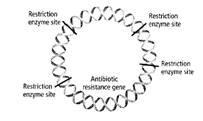
Concept explainers
Introduction:
Researchers use genetic engineering to manipulate DNA. It makes production of organisms that contain individual genes from another organism possible. Recombinant DNA contains DNA from different sources. It can be made by connecting fragments of DNA from different sources. DNA ligase is used to join a plasmid DNA and a DNA fragment obtained from another genome to create a recombinant plasmid DNA.
Answer to Problem 14A
Correct answer :
The correct answer is option A. to carry the foreign DNA into the host cell
Explanation of Solution
Explanation/justification for the correct answer:
Option A. to carry the foreign DNA into the host cell- The illustration given below shows a recombinant plasmid. Foreign DNA containing the gene for antibiotic resistance is inserted into the plasmid vector. The recombinant plasmid then carries the foreign DNA into the host bacterial cell where it replicates independently of the bacterial chromosome. Millions of bacteria are produced containing the recombinant DNA molecules. These are called gene clones. This technique is used in gene cloning. Hence this is the correct option.

Explanation for incorrect answer:
Option B. to identify the source of DNA as foreign- The given illustration shows a recombinant plasmid. Foreign DNA containing the gene for antibiotic resistance is inserted into the plasmid vector. The recombinant plasmid then carries the foreign DNA into the host bacterial cell. It does not identify the source of DNA as foreign. Hence, this is not the correct option.
Option C. to identify the host cell that has taken up the gene of interest- The given illustration shows a recombinant plasmid. Foreign DNA containing the gene for antibiotic resistance is inserted into the plasmid vector. The recombinant plasmid then carries the foreign DNA into the host bacterial cell. It does not identify the host cell that has taken up the gene of interest.
Hence, this is not the correct option.
Option D. make the foreign DNA susceptible to digestion with enzymes- The given illustration shows a recombinant plasmid. Foreign DNA containing the gene for antibiotic resistance is inserted into the plasmid vector. The recombinant plasmid then carries the foreign DNA into the host bacterial cell. It does not make the foreign DNA susceptible to digestion with enzymes. Hence, this is not the correct option.
Chapter 13 Solutions
Biology Illinois Edition (Glencoe Science)
Additional Science Textbook Solutions
Campbell Essential Biology (7th Edition)
Anatomy & Physiology (6th Edition)
Cosmic Perspective Fundamentals
Chemistry: An Introduction to General, Organic, and Biological Chemistry (13th Edition)
Campbell Biology (11th Edition)
Genetic Analysis: An Integrated Approach (3rd Edition)
- Which evidence-based stress management techniques are most effective in reducing chronic stress and supporting college students’ academic success?arrow_forwardstudents in a science class investiged the conditions under which corn seeds would germinate most successfully. BAsed on the results which of these factors appears most important for successful corn seed germination.arrow_forwardI want to write the given physician orders in the kardex formarrow_forward
- Amino Acid Coclow TABle 3' Gly Phe Leu (G) (F) (L) 3- Val (V) Arg (R) Ser (S) Ala (A) Lys (K) CAG G Glu Asp (E) (D) Ser (S) CCCAGUCAGUCAGUCAG 0204 C U A G C Asn (N) G 4 A AGU C GU (5) AC C UGA A G5 C CUGACUGACUGACUGAC Thr (T) Met (M) lle £€ (1) U 4 G Tyr Σε (Y) U Cys (C) C A G Trp (W) 3' U C A Leu בוט His Pro (P) ££ (H) Gin (Q) Arg 흐름 (R) (L) Start Stop 8. Transcription and Translation Practice: (Video 10-1 and 10-2) A. Below is the sense strand of a DNA gene. Using the sense strand, create the antisense DNA strand and label the 5' and 3' ends. B. Use the antisense strand that you create in part A as a template to create the mRNA transcript of the gene and label the 5' and 3' ends. C. Translate the mRNA you produced in part B into the polypeptide sequence making sure to follow all the rules of translation. 5'-AGCATGACTAATAGTTGTTGAGCTGTC-3' (sense strand) 4arrow_forwardWhat is the structure and function of Eukaryotic cells, including their organelles? How are Eukaryotic cells different than Prokaryotic cells, in terms of evolution which form of the cell might have came first? How do Eukaryotic cells become malignant (cancerous)?arrow_forwardWhat are the roles of DNA and proteins inside of the cell? What are the building blocks or molecular components of the DNA and proteins? How are proteins produced within the cell? What connection is there between DNA, proteins, and the cell cycle? What is the relationship between DNA, proteins, and Cancer?arrow_forward
- please fill in the empty sports, thank you!arrow_forwardIn one paragraph show how atoms and they're structure are related to the structure of dna and proteins. Talk about what atoms are. what they're made of, why chemical bonding is important to DNA?arrow_forwardWhat are the structure and properties of atoms and chemical bonds (especially how they relate to DNA and proteins).arrow_forward
 Human Anatomy & Physiology (11th Edition)BiologyISBN:9780134580999Author:Elaine N. Marieb, Katja N. HoehnPublisher:PEARSON
Human Anatomy & Physiology (11th Edition)BiologyISBN:9780134580999Author:Elaine N. Marieb, Katja N. HoehnPublisher:PEARSON Biology 2eBiologyISBN:9781947172517Author:Matthew Douglas, Jung Choi, Mary Ann ClarkPublisher:OpenStax
Biology 2eBiologyISBN:9781947172517Author:Matthew Douglas, Jung Choi, Mary Ann ClarkPublisher:OpenStax Anatomy & PhysiologyBiologyISBN:9781259398629Author:McKinley, Michael P., O'loughlin, Valerie Dean, Bidle, Theresa StouterPublisher:Mcgraw Hill Education,
Anatomy & PhysiologyBiologyISBN:9781259398629Author:McKinley, Michael P., O'loughlin, Valerie Dean, Bidle, Theresa StouterPublisher:Mcgraw Hill Education, Molecular Biology of the Cell (Sixth Edition)BiologyISBN:9780815344322Author:Bruce Alberts, Alexander D. Johnson, Julian Lewis, David Morgan, Martin Raff, Keith Roberts, Peter WalterPublisher:W. W. Norton & Company
Molecular Biology of the Cell (Sixth Edition)BiologyISBN:9780815344322Author:Bruce Alberts, Alexander D. Johnson, Julian Lewis, David Morgan, Martin Raff, Keith Roberts, Peter WalterPublisher:W. W. Norton & Company Laboratory Manual For Human Anatomy & PhysiologyBiologyISBN:9781260159363Author:Martin, Terry R., Prentice-craver, CynthiaPublisher:McGraw-Hill Publishing Co.
Laboratory Manual For Human Anatomy & PhysiologyBiologyISBN:9781260159363Author:Martin, Terry R., Prentice-craver, CynthiaPublisher:McGraw-Hill Publishing Co. Inquiry Into Life (16th Edition)BiologyISBN:9781260231700Author:Sylvia S. Mader, Michael WindelspechtPublisher:McGraw Hill Education
Inquiry Into Life (16th Edition)BiologyISBN:9781260231700Author:Sylvia S. Mader, Michael WindelspechtPublisher:McGraw Hill Education





